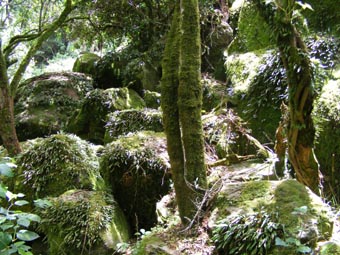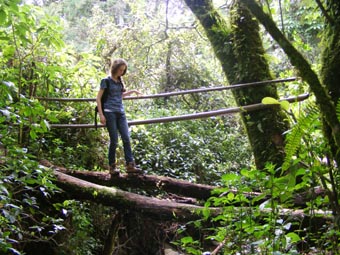 Previous expeditions by Charles
Griswold and colleagues had shown that Cameroon is home to a great
diversity of spiders, including many undescribed pholcids.
Unfortunately, many species from previous collections are represented
by one or a few specimens only, and no material had been available that
was suitable for DNA sequencing. In April 2009 I visited Cameroon
together with my daughter Janina, and we travelled about 3,000 km
covering parts of the Central, Littoral, South, Northwestern and
Western Regions.
Previous expeditions by Charles
Griswold and colleagues had shown that Cameroon is home to a great
diversity of spiders, including many undescribed pholcids.
Unfortunately, many species from previous collections are represented
by one or a few specimens only, and no material had been available that
was suitable for DNA sequencing. In April 2009 I visited Cameroon
together with my daughter Janina, and we travelled about 3,000 km
covering parts of the Central, Littoral, South, Northwestern and
Western Regions.With over 700 adult specimens representing 33 species, this was one of my most successful expeditions so far. We collected 22 new species, most of them belonging to the genera Smeringopina and Pholcus. In places like the lowland rainforest near Kribi (below left) and the montane forest near Mbouda (right), pholcids were just everywhere and few other macroscopic animals seem to have similar abundances.


One central aim of the entire expedition was the collection of fresh material of the genus Pholcus, which was the topic of a worldwide revision (in the meantime publised; see Huber 2011). Interestingly, Pholcus species in Cameroon are found in a variety of habitats, and the morphology of each species nicely reflects its preferred microhabitat. The species below on the left (Pholcus bamboutos) is at rest pressed against the bark of trees or against rocks; it is rather large and dark. The species on the right (top; Pholcus kribi) lives under dead leaves on the ground; it is tiny and also dark. The third species shown here (Pholcus debilis) lives on the underside of green (alive) leaves; it is pale yellow to greenish. Thus, while pholcids are ubiquitous, they are usually well camouflaged and it requires a close look to find them.
A second large monograph has been published including the Smeringopina we collected in Cameroon (Huber 2013). And an overview of the Pholcidae from Central Africa (Huber et al. 2014).

 Several people
contributed
substantially to the success of this trip: Philippe Le Gall, Research
Scientist at the IRD
in Yaounde, who was of tremendous help with bureauratic and logistic
problems and who passionately shared his huge knowledge about Africa
in general and about African arthropods in particular; Roger Kamga, our
driver and
guide,
who always knew the best spots and savely brought us there and back
again; and my daughter, who preferred
the beach at Kribi but who also developed a good eye for tiny
leaf-dwelling pholcids. I
thank the German Research Foundation for financing this expedition
(DFG Project HU 980/9-1).
Several people
contributed
substantially to the success of this trip: Philippe Le Gall, Research
Scientist at the IRD
in Yaounde, who was of tremendous help with bureauratic and logistic
problems and who passionately shared his huge knowledge about Africa
in general and about African arthropods in particular; Roger Kamga, our
driver and
guide,
who always knew the best spots and savely brought us there and back
again; and my daughter, who preferred
the beach at Kribi but who also developed a good eye for tiny
leaf-dwelling pholcids. I
thank the German Research Foundation for financing this expedition
(DFG Project HU 980/9-1).